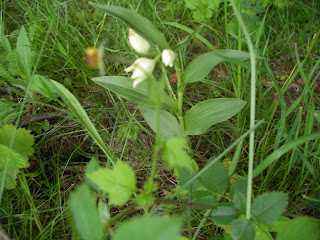Commom Spotted Orchid are now approaching their peak and there are some cracking plants and colonies that can be seen now...please send colonies in on Adnoto and dont assume someone else will!
Fragrant Orchids are also mid way coming into flower now, look out for the long spurs at the back of the flowers as in this one below. They do not have spotted leaves and stand out amonst the common spotteds with which they may occur as appearing more delicate.
Other Orchids will be some time in coming into flower.
The Frog Orchids on Dunstable Downs are still being shy and will be another two or three weeks before they are more easy to find. Pyramid Orchid is only just begining to show some colour in their spikes and Bee Orchid wil be out in the next two weeks also.
Frog Orchid leaves
Recording the presence and absence of our orchids is important to get an idea of the current distributions and population sizes. For our rarer orchids i am keen that we find out something about what is happening to their populations. Most have retracted their range in recent decades. Do they get pollinated and set seed?
Our Wildlife Trust has been studying Man and Musk Orchid at Totternhoe. If pollination has been carried out then the seed pods enlarge as the seeds develop.
A similar study of the Burnt -tip Orchids is important as in the last few years all the flowering plants have either been trodden on or eaten by rabbits before seed has been set.
Burnt -tip with three lower seed pods swelling indicating that the these flowers have been pollinated. The remaining thin seed pods have not and will quickly wither once flowering has finished
The Burnt-tips have had some plants protected from rabbits and feet with wire cages so we can learn if pollinators are present and seed can be set.
I am interested if you see swelling seed pods on the orchids you see and also if you see pollinators at work!
White Helleborine are now out in good numbers in places, look out for them particularly beneath Beech trees on the chalk. Although they can be out in grassland also.
White Helleborine
Happy hunting!





